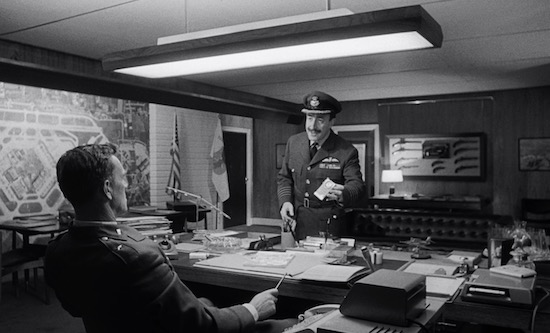Transistor Radio

Photo: Dr. Strangelove
A little over 15 minutes into Stanley Kubrick’s hilarious yet terrifying Dr. Strangelove: Or How I Learned to Stop Worrying and Love the Bomb (1964), Group Captain Lionel Mandrake (Peter Sellers) reaches into a printer console and finds a transistor radio. Burpleson Air Force Base is under condition red, the 843rd Bomb Wing on its way to carry out a bombing run inside the Soviet Union. Mandrake is under orders from General Jack D. Ripper (Sterling Hayden) to impound all privately owned radios lest they be used to issue instructions to saboteurs.
Mandrake switches on the radio. Music blares from its tinny speaker, specifically the kind of uptempo fake rock and roll that early-to-mid 1960s orchestral combos incorporated into their setlists while waiting for what they thought of as a “teenage fad” to pass. Radio in hand, Mandrake heads for General Ripper’s office. How can the U.S.A. be in a shooting war with the USSR if civilian radio is broadcasting as if nothing is wrong? But when confronted with this evidence, Ripper confesses he has no intention of recalling the bombers. He then tells Mandrake to make him “a drink of grain alcohol and rainwater — and help yourself to whatever you’d like.” War is too important to leave to the politicians, says Ripper. Purity of bodily fluids must be maintained against the Commie threat.
Transistor radio technology was barely a decade old when Dr. Strangelove premiered. The first commercially produced transistor radio, the Regency TR-1, a joint production of Texas Instruments and Industrial Development Engineering Associates (I.D.E.A.), debuted in 1954. Three years later, Sony introduced the TR-63, a smaller, mass-produced model that took the American market by storm, aided by a wave of baby-boom teenagers hungry for rock-and-roll. In 1963 alone, ten million transistor radios were sold in the United States.
Kubrick paid homage to the teen love affair with the transistor radio in an earlier film. When Humbert Humbert (James Mason) meets the bikini-clad Lolita (Sue Lyon) in Kubrick’s 1962 adaptation of Vladmir Nabokov’s novel, the soundtrack’s theme song (“Lolita Ya Ya”) plays through her radio. “Darling, turn that down, please!” says Lolita’s doomed mother (Shelley Winters).
Of course, the transistor radio in Dr. Strangelove was more than mere window dressing. Without it, Mandrake will never know that what appears to be a mere SNAFU is rapidly deteriorating into a FUBAR with global consequences, thanks to an unstable commanding officer.

